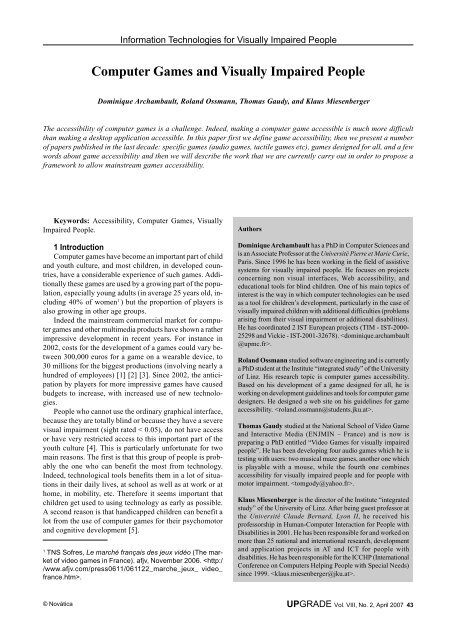Download full issue (PDF 2.1MB) - Council of European ...
Download full issue (PDF 2.1MB) - Council of European ...
Download full issue (PDF 2.1MB) - Council of European ...
You also want an ePaper? Increase the reach of your titles
YUMPU automatically turns print PDFs into web optimized ePapers that Google loves.
© Novática<br />
Information Technologies for Visually Impaired People<br />
Computer Games and Visually Impaired People<br />
Dominique Archambault, Roland Ossmann, Thomas Gaudy, and Klaus Miesenberger<br />
The accessibility <strong>of</strong> computer games is a challenge. Indeed, making a computer game accessible is much more difficult<br />
than making a desktop application accessible. In this paper first we define game accessibility, then we present a number<br />
<strong>of</strong> papers published in the last decade: specific games (audio games, tactile games etc), games designed for all, and a few<br />
words about game accessibility and then we will describe the work that we are currently carry out in order to propose a<br />
framework to allow mainstream games accessibility.<br />
Keywords: Accessibility, Computer Games, Visually<br />
Impaired People.<br />
1 Introduction<br />
Computer games have become an important part <strong>of</strong> child<br />
and youth culture, and most children, in developed countries,<br />
have a considerable experience <strong>of</strong> such games. Additionally<br />
these games are used by a growing part <strong>of</strong> the population,<br />
especially young adults (in average 25 years old, including<br />
40% <strong>of</strong> women 1 ) but the proportion <strong>of</strong> players is<br />
also growing in other age groups.<br />
Indeed the mainstream commercial market for computer<br />
games and other multimedia products have shown a rather<br />
impressive development in recent years. For instance in<br />
2002, costs for the development <strong>of</strong> a games could vary between<br />
300,000 euros for a game on a wearable device, to<br />
30 millions for the biggest productions (involving nearly a<br />
hundred <strong>of</strong> employees) [1] [2] [3]. Since 2002, the anticipation<br />
by players for more impressive games have caused<br />
budgets to increase, with increased use <strong>of</strong> new technologies.<br />
People who cannot use the ordinary graphical interface,<br />
because they are totally blind or because they have a severe<br />
visual impairment (sight rated < 0.05), do not have access<br />
or have very restricted access to this important part <strong>of</strong> the<br />
youth culture [4]. This is particularly unfortunate for two<br />
main reasons. The first is that this group <strong>of</strong> people is probably<br />
the one who can benefit the most from technology.<br />
Indeed, technological tools benefits them in a lot <strong>of</strong> situations<br />
in their daily lives, at school as well as at work or at<br />
home, in mobility, etc. Therefore it seems important that<br />
children get used to using technology as early as possible.<br />
A second reason is that handicapped children can benefit a<br />
lot from the use <strong>of</strong> computer games for their psychomotor<br />
and cognitive development [5].<br />
1 TNS S<strong>of</strong>res, Le marché français des jeux vidéo (The market<br />
<strong>of</strong> video games in France). afjv, November 2006. .<br />
Authors<br />
Dominique Archambault has a PhD in Computer Sciences and<br />
is an Associate Pr<strong>of</strong>essor at the Université Pierre et Marie Curie,<br />
Paris. Since 1996 he has been working in the field <strong>of</strong> assistive<br />
systems for visually impaired people. He focuses on projects<br />
concerning non visual interfaces, Web accessibility, and<br />
educational tools for blind children. One <strong>of</strong> his main topics <strong>of</strong><br />
interest is the way in which computer technologies can be used<br />
as a tool for children’s development, particularly in the case <strong>of</strong><br />
visually impaired children with additional difficulties (problems<br />
arising from their visual impairment or additional disabilities).<br />
He has coordinated 2 IST <strong>European</strong> projects (TIM - IST-2000-<br />
25298 and Vickie - IST-2001-32678). .<br />
Roland Ossmann studied s<strong>of</strong>tware engineering and is currently<br />
a PhD student at the Institute “integrated study” <strong>of</strong> the University<br />
<strong>of</strong> Linz. His research topic is computer games accessibility.<br />
Based on his development <strong>of</strong> a game designed for all, he is<br />
working on development guidelines and tools for computer game<br />
designers. He designed a web site on his guidelines for game<br />
accessibility. .<br />
Thomas Gaudy studied at the National School <strong>of</strong> Video Game<br />
and Interactive Media (ENJMIN – France) and is now is<br />
preparing a PhD entitled “Video Games for visually impaired<br />
people”. He has been developing four audio games which he is<br />
testing with users: two musical maze games, another one which<br />
is playable with a mouse, while the fourth one combines<br />
accessibility for visually impaired people and for people with<br />
motor impairment. .<br />
Klaus Miesenberger is the director <strong>of</strong> the Institute “integrated<br />
study” <strong>of</strong> the University <strong>of</strong> Linz. After being guest pr<strong>of</strong>essor at<br />
the Université Claude Bernard, Lyon II, he received his<br />
pr<strong>of</strong>essorship in Human-Computer Interaction for People with<br />
Disabilities in 2001. He has been responsible for and worked on<br />
more than 25 national and international research, development<br />
and application projects in AT and ICT for people with<br />
disabilities. He has been responsible for the ICCHP (International<br />
Conference on Computers Helping People with Special Needs)<br />
since 1999. .<br />
UPGRADE Vol. VIII, No. 2, April 2007 43


